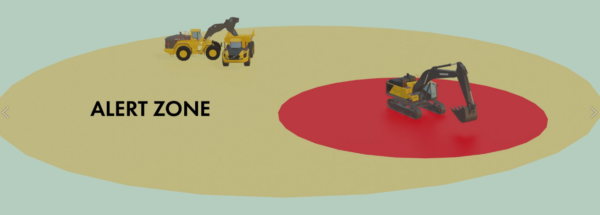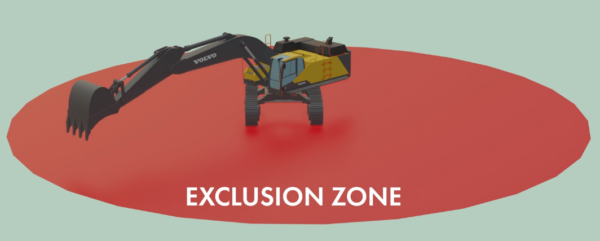Excavators and loaders are large machines with blind spots that make it dangerous for pedestrians when they are working in the same area. Loaders and wheeled excavators are capable of moving quickly, so it’s important that everyone on the worksite understands where the potential points of impact are.
Pedestrians approaching machinery
Three zones should be considered when pedestrians and machinery are working on-site.
Safe zone
Pedestrians and machinery are sufficiently far away from one another that there is no danger. Pedestrians are unlikely to come into contact with moving plant, and there could be separation such as barriers.
Alert zone
Pedestrians and machinery are working in the same area. Care is required. Use the horn, shout out, hand gestures, eye contact, radios, etc.

Exclusion zone
If a pedestrian enters this zone, the machine operator much stop the machine.
The exclusion zone is where the pedestrian is close enough that they could be hit by the counterweight or bucket as the excavator is slewing, could be run over if the excavator or loader moves, or could be injured by falling materials.

The size of the exclusion zone depends on the size and reach of the machine, and what the machine is working on. The exclusion zone might not be a circle, as shown, because it could extend to hazards the machines are working with, such as conveyer belts. Each machine on the site has its own exclusion and alert zones, and they will intersect from time-to-time.
Additional information is available in our excavator operator’s certificate course.
Getting workers to the site
Use a designated car parking area for workers’ vehicles and cone off a walkway so that people are not simply randomly making their way to the site, and vehicles know that it is a dedicated walkway. These paths should avoid alert and exclusion zones.
Ensure good visibility and lighting
Tight corners and areas where operators need to reverse are scenarios where blind spots are created. Prevent pedestrians from entering these areas. Use convex mirrors to help operators see around their vehicle.
Ensure crossing points are clearly visible with no obstructions. Anywhere a pedestrian may come near to equipment operating, lighting should be good.
